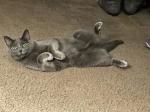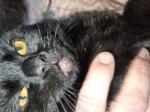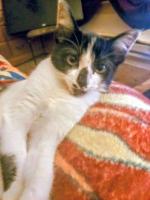The Cat Fancy: Appreciating the Feline
The Cat Fancy, as defined by reference.com (using Wikipedia), is a form of animal fancy.
Animal fancy has this entry in reference.com:
Animal fancy is a hobby involving the appreciation, promotion, and/or breeding of pet or domestic animals.
Fancy may include pet and exotic pet ownership, showing, trialling and other competitions, breeding and judging. Hobbyists may simply collect specimens of the animal in appropriate enclosures, such as aquaria and aviaries. Fanciers with means may keep hobby farms or private zoos. There are many animal fancy clubs and associations in the world catering for everything from pigeons to Irish Wolfhounds; members may own many animals or none at all.
"Animal_fancy." Wikipedia, the free encyclopedia. 25 May. 2008.
The History of Cat Shows and Breeds
As far back as 1598, at the annual St. Giles Fair in Winchester, England, prizes were handed out to felines for the best mouser and ratter. Modern cat shows, however, got their start in 1871, at London's Crystal Palace.
This first of the modern cat shows sported 170 cat and kitten contestants and included Siamese, and a large English tabby cat weighing 21 lbs. Harrison Weir, an animal lover and artist, organized the show to display the different colors, coat patterns, and breeds of cat. Cats were entered in the show by color, and various prizes were awarded, including one for fattest cat.
Harrison Weir went on to write Our Cats, which became a sort of bible for cat show organizers. For a time, Weir was President of the National Cat Club, but resigned after discovering that members were more interested in claiming prizes than promoting the welfare of cats.
More shows followed on the success of that first one, and eventually, in 1895, the first American show was held at Madison Square Garden in New York. (Some sources report that the first American show was actually held at a museum on Broadway in 1881).
These shows led to the first written pedigrees for cats, as owners of unique and different cat breeds began keeping detailed records. Cat clubs and organizations began to form, and societies of the Cat Fancy were born.
Governing Bodies of the Cat Fancy
The National Cat Club came about in 1887 in Britain, and most clubs followed their rules when running shows. They published the first stud book in 1895, and then another club appeared on the scene a year later.
In 1910, however, they merged with the Governing Council of the Cat Fancy (GCCF). That organization ran all things cat in Britain until another entity, the Cat Association of Britain (CA) was established in 1983.
In the US, the first American registry was the American Cat Association. The ACA formed in 1899. Today, there are a number of cat bodies in North America that allow U.S. and Canadian cats to enter the same shows.
The largest one of these organizations is the Cat Fanciers' Association. The CFA currently recognizes 42 pedigreed breeds for championship class, and 2 in the miscellaneous class (the Lykoi and Khao Manee). Here's the list of cat breeds recognized by the CFA.
If you count the ACA as a registry and not a "cat organization," then the CFA is the oldest American cat organization, having been founded in 1906. They held their first cat shows in Buffalo, New York, and Detroit that same year. The CFA has affilated clubs in Canada and Japan.
There is also The International Cat Association (TICA), American Cat Council (ACC), Cat Fanciers' Federation (CFF), United Cat Federation (UCA), the American Association of Cat Enthusiasts (AACE), and the Canadian Cat Association (CCA).
The ACC holds "British-syle" shows, where exhibitors are required to leave the area during judging. The AACE shows breeds that are not accepted into the larger organizations.
New Zealand, South Africa, and Australia all have their own national bodies as well as other organizations, and many of them follow GCCF rules.
In Europe, a number of countries have two or more cat bodies. Typically, one of the organizations from these countries is affiliated with the Federation International Feline (FIFe).
FIFe is the largest and most powerful feline association in the world, and has thousands of members. FIFe, the CA, and many US organizations have training and examination programs for judges.
The GCCF has no testing process, but provides instead for experienced breeders to be nominated and approved by a Council meeting to become probationary judges. Initially, they judge kittens and eventually may move up to full judge status.
Breed Standards
Each Cat Fancy organization, as governing body, has its own list of cat breeds that are recognized, as well as certain published breed standards.
These standards may vary between countries, as well as between bodies. In addition, the cat breed standards are amended over the years as preferences for cat body type, head shape, coat color, and other characteristics change.
There are several breeds where the modern version of the breed looks very different from the traditional. For example, the modern Siamese has a very sleek and lean body and a wedge shaped head.
The traditional Siamese, however, has a thicker body and a rounder face. These are also known as Apple-headed Siamese or Opal cats, and have actually been making a bit of a comeback. I really like the look and personalities of these cats, as well as their long haired cousins, the Balinese and Javanese.
If you're planning on registering or showing a cat, make sure you get the relevant information from the various governing bodies. As breed standards change (sometimes it's just a matter of a color becoming acceptable), and new breeds are registered and approved (a lengthy process), you'll need to understand the requirements.
Breeding and New Breeds
The various organizations have different requirements for recognizing and registering different breeds. Breeds have to be distinctly different from each other in some way.
They also usually need to be consistent and breed true for a minimum number of generations and produce a certain number of examples. Of course, they also need to show that the breed has no harmful defects.
Most new breeds are based on existing breeds or breed types. Some breeds are actually variations of existing breeds that gained acceptance. The Balinese cat, for example, is a natural genetic long-haired mutation of the Siamese. So, the Balinese is a "silky-haired" Siamese.
The Javanese is a essentially a Balinese in different colors. The Colorpoint Shorthair is essentially a Siamese of a different color. According to the CFA, some Javanese have cropped up spontaneously in some Colorpoint Shorthair litters, but most of them are actually a cross between Balinese and Colorpoint Shorthair.
Sometimes breeders will perpetuate these mutations, such as long-hair versus short hair, or the fold of the ears in the Scottish Fold, and a new breed will be developed.
Other times, breeders set out to create a breed with specific qualities, such as the California Spangled cat, which was born from a variety of breeds. Others sometimes mix wild cats and form a hybrid breed like Bengals, or the Savannah cat.
Tracing bloodlines is done when breeders register a particular line's pedigree. In order to ensure healthy cats, breeders will weed out imperfections, bloodline specific diseases, and breed specific weaknesses. This is in contrast to "kitty-mills" and irresponsible backyard breeders who don't screen for illness or defects.



Comments: What do you think?
Have your say about what you just read. Leave me a comment in the box below.